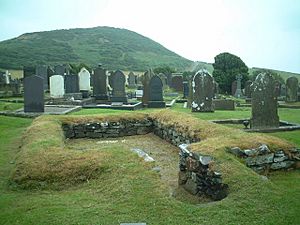Keeill facts for kids
A Keeill (pronounced "keel") is a special kind of small, simple chapel found on the Isle of Man. These chapels were built a long time ago, between the 6th and 12th centuries. They are important historical sites that tell us about early Christianity on the island.
Contents
What's in a Name?
The word "Keeill" comes from the Manx Gaelic language, which is spoken on the Isle of Man. In Manx Gaelic, "keeill" means "chapel." The word originally came from the Latin word cella, which meant a small room or a storeroom. Over time, it came to mean a small room where a monk might live, and then a small chapel.
Where and When They Were Built
Some similar small chapels have been found in other places, like Islay in Scotland.
The very first Keeills were probably made of wood or other materials that didn't last. So, the ones we see today are actually later versions, mostly built between the 8th and 12th centuries. These later Keeills were made from different materials, like rough stones, or even turf (grass and soil) with wood frames. Sometimes, people have found traces of clay or plaster on the walls.
Keeills might have stopped being used for a while when Viking settlers arrived on the Isle of Man. But after the Vikings became Christian, many Keeills were rebuilt, sometimes right on the same spots as the older ones.
Many Keeills were built on small hills or mounds. These spots were often important before the Keeills were built, sometimes being old burial sites from the Bronze-Age. They were also often built near a spring or a "holy well," which was a special water source. Many Keeills are surrounded by old cemeteries, and some of these burial grounds might even be older than the Christian chapels themselves. Some Keeills also have a low wall or bank of earth around them.
How Many Keeills Are There?
Historians have found records of at least 174 Keeills on the Isle of Man, and there might have been over 200 in total. However, only about 35 of them can be easily seen today. Many Keeills were lost because bigger, newer churches were built on top of them, like Kirk Maughold. Others were destroyed by people in the 1800s who were looking for old treasures instead of carefully studying the history of the sites.
What Keeills Looked Like
Even though Keeills were all small chapels, their sizes could be quite different.
A Norwegian professor named Carl J. S. Marstrander studied Keeills a lot in the 1930s. He found that some were very small, like the Ballachrink Keeill, which was only about 10 feet long and 6 feet wide inside. Others were much larger, like St Patrick's Chapel, which was about 57 feet long and 18 feet wide. The walls of Keeills were usually thick, between 2 and 5 feet wide. Outside, the walls were often protected by a bank of earth and stones.
Most Keeills were shaped like a rectangle. They usually didn't have separate rooms inside, like a main area and a smaller altar area. The door was often narrow and taller at the bottom, usually placed in the wall at the west end. There was usually only one window, built about 2 or 3 feet above the floor. The altar, which is a special table used for religious ceremonies, was always placed against the eastern wall and was about 2 feet high.
Keeills on Time Team
In 2007, the TV show Time Team excavated a Keeill. What they found matched the general description of Keeills: it had thick walls, a rectangular shape, no clear rooms inside, a single narrow entrance, and an altar at the eastern end.
See also
- St Trinian's Church
- Registered Buildings of the Isle of Man
- Keills Chapel, Argyll, Scotland


